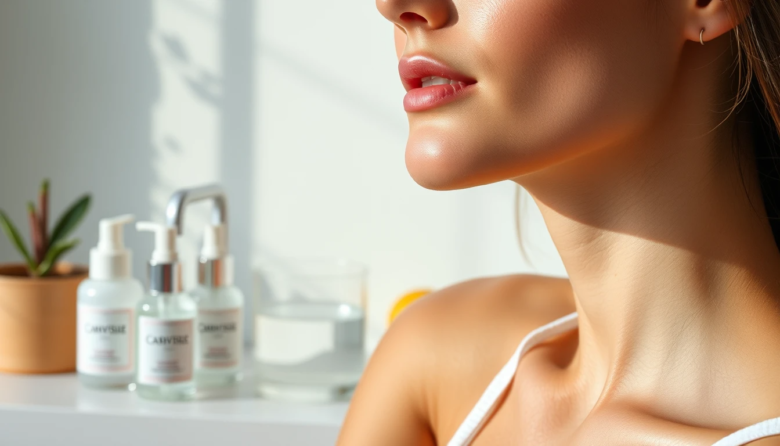Introduction
Achieving and maintaining radiant, healthy skin is a goal for many, yet common skin concerns such as cellulite and stretch marks often diminish our confidence and affect our appearance. These conditions, while natural, are influenced by a variety of factors—genetic, hormonal, environmental, and lifestyle-related. In a world where preventative care is becoming increasingly important, daily rituals can play a critical role in maintaining smooth, resilient skin and minimizing the development of these skin imperfections.
This article is designed to provide you with a comprehensive guide to daily rituals that not only enhance your skin’s natural glow but also serve as preventative strategies against cellulite and stretch marks. In Part 1, we will focus on establishing a solid foundation for skin health through understanding your skin’s needs, implementing effective daily skincare routines, and adopting nutritional and lifestyle strategies that support skin resilience. By integrating these evidence-based practices into your everyday routine, you can significantly improve your skin’s appearance and overall health. Part 2 will further explore advanced techniques, emerging treatments, and expert recommendations for long-term skin care.
Understanding Your Skin’s Needs
The Science Behind Radiant Skin
Healthy skin is the result of well-maintained cellular structures, particularly the collagen and elastin fibers that provide firmness and elasticity. The skin is composed of three main layers—the epidermis, dermis, and subcutaneous tissue. The epidermis serves as the outer protective barrier, while the dermis houses collagen, elastin, and other components critical for structural integrity. The subcutaneous tissue, made primarily of fat cells, can be the site of cellulite formation when fat deposits push against the connective tissue.
When the skin is nourished and well cared for, its ability to regenerate and repair itself is optimized. This resilience is essential for preventing the weakening of the dermal structure that leads to the formation of cellulite and stretch marks. A deep understanding of these processes enables us to tailor our daily routines to not only enhance our skin’s natural beauty but also fortify it against common stressors.
Factors That Influence Skin Health
The appearance of cellulite and stretch marks is multifactorial. Several key factors influence skin health, including:
- Internal Factors: Genetics, hormones, and the natural aging process play a significant role. For example, hormonal fluctuations during puberty, pregnancy, or menopause can accelerate changes in skin elasticity.
- External Factors: Environmental stressors such as sun exposure, pollution, and temperature variations can damage skin cells and degrade collagen and elastin.
- Nutrition and Hydration: The nutrients you provide your body directly affect your skin’s ability to repair and regenerate. A diet rich in vitamins (especially A, C, and E), minerals, and antioxidants supports collagen production and combats inflammation, while adequate hydration maintains skin elasticity.
Understanding these elements forms the basis for developing effective daily rituals that target the root causes of skin imperfections.
Establishing a Daily Skincare Routine
A consistent, well-thought-out skincare routine is paramount in achieving radiant skin. Daily care not only keeps the skin clean and nourished but also serves as the first line of defense against the formation of cellulite and stretch marks.
Morning Routine
Starting your day with a gentle yet effective skincare routine can set a positive tone for your skin’s health.
Cleansing
- Gentle, Hydrating Cleanser:
Use a mild cleanser that removes impurities without stripping your skin of its natural oils. Look for ingredients like glycerin and hyaluronic acid that hydrate while cleansing. - Avoid Harsh Chemicals:
Stay away from cleansers containing sulfates or alcohol, which can cause dryness and irritation, potentially weakening the skin’s barrier over time.
Toning and Hydration
- Balancing Toner:
Apply a toner that helps balance the skin’s pH and prepares it for subsequent hydration steps. A toner with soothing ingredients like chamomile or rosewater can calm the skin. - Light Moisturizer:
Choose a lightweight, non-comedogenic moisturizer that provides hydration without feeling heavy. Moisturizers that contain hyaluronic acid can lock in moisture and maintain skin plumpness. - Sun Protection:
Sunscreen is critical. Use a broad-spectrum sunscreen with at least SPF 30 every morning. UV rays can accelerate collagen breakdown, so protecting your skin from sun damage is essential for long-term skin health.
Evening Routine
An effective evening routine focuses on thorough cleansing, repair, and deep hydration, allowing your skin to regenerate overnight.
Deep Cleansing
- Remove Impurities:
Begin with a gentle cleanser to remove makeup, pollutants, and the accumulated oils of the day. Double cleansing might be beneficial for those who wear makeup or sunscreen. - Exfoliation (Occasional):
Incorporate mild chemical exfoliants, such as glycolic or lactic acid, 1-2 times a week to promote cell turnover and ensure that active ingredients can penetrate more effectively.
Targeted Treatments
- Serums and Actives:
After cleansing, apply serums formulated with active ingredients that support collagen synthesis and skin repair. Retinoids, peptides, and antioxidants (like vitamin C) are excellent choices. These ingredients help improve skin texture, reduce fine lines, and support overall skin resilience. - Rich Moisturizing Cream:
Seal in the benefits of your treatments with a richer, nourishing cream or oil-based moisturizer at night. This step supports skin regeneration and maintains hydration levels while you sleep.
Weekly Rituals
In addition to daily routines, weekly treatments can significantly enhance your skin’s condition and prevent the development of cellulite and stretch marks.
Exfoliation
- Chemical Exfoliants:
Use a gentle exfoliant to remove dead skin cells and promote skin renewal. Avoid abrasive scrubs that might irritate the skin. - Frequency:
Exfoliate 1-2 times per week to ensure that your skin remains smooth and that active ingredients can be absorbed more effectively.
Dry Brushing and Massage
- Dry Brushing:
Incorporate dry brushing into your routine to stimulate circulation and encourage lymphatic drainage. This practice not only helps in reducing the appearance of cellulite by promoting smoother skin but also enhances overall skin tone. - Self-Massage:
A gentle self-massage with a facial roller or your fingertips can improve blood flow and help distribute subcutaneous fat more evenly, reducing the prominence of stretch marks.
Nutritional and Hydration Strategies
Diet for Skin Resilience
What you eat plays a crucial role in skin health. Incorporate a diet rich in vitamins, minerals, and antioxidants that support collagen production and reduce inflammation.
- Antioxidant-Rich Foods:
Consume a variety of fruits and vegetables, particularly those high in vitamins A, C, and E, which help to protect and repair the skin. - Omega-3 Fatty Acids:
Include sources of omega-3 fatty acids such as fish, walnuts, and flaxseeds to support skin cell membranes and promote elasticity. - Anti-Inflammatory Diet:
A diet that minimizes processed foods and sugars can help reduce inflammation, a key factor in the formation of cellulite and stretch marks.
Hydration
Staying well-hydrated is essential for maintaining skin elasticity and overall health. Aim for at least 8 glasses of water a day, and consider supplementing with hydrating beverages like herbal teas or water infused with fruits.
Lifestyle Adjustments for Skin Health
In addition to skincare and nutrition, your lifestyle habits significantly influence your skin’s appearance and resilience.
Regular Physical Activity
- Exercise Benefits:
Engage in both cardiovascular and strength training exercises to improve circulation and muscle tone. Improved blood flow ensures that nutrients reach the skin efficiently, supporting repair and regeneration. - Targeted Exercises:
Focus on exercises that tone the areas prone to cellulite, such as squats and lunges, which help to firm the muscles and reduce the appearance of dimpling.
Stress Management and Quality Sleep
- Managing Stress:
Chronic stress can lead to hormonal imbalances that adversely affect skin health. Incorporate stress management techniques such as meditation, yoga, or deep-breathing exercises into your daily routine. - Sleep Hygiene:
Aim for 7-9 hours of quality sleep per night. Sleep is when your body repairs and regenerates skin cells, making it an essential component of any anti-aging or skin-care regimen.
Conclusion of Part 1
In this first part of our guide on daily rituals for radiant skin, we have laid the groundwork for a comprehensive approach to preventing cellulite and stretch marks. We began by understanding the anatomy of healthy skin and the multifactorial causes behind cellulite and stretch marks, including genetic, hormonal, and lifestyle factors. We then explored the critical elements of an effective daily skincare routine—both morning and evening rituals—emphasizing the importance of gentle cleansing, hydration, sun protection, and targeted treatments.
Additionally, we discussed the significance of weekly rituals like exfoliation and dry brushing to promote skin renewal and circulation. We also highlighted the impact of nutrition and hydration, as well as lifestyle adjustments such as regular exercise, stress management, and proper sleep, all of which contribute to maintaining healthy, resilient skin.
Daily Rituals for Radiant Skin: Preventative Strategies Against Cellulite and Stretch Marks
Advanced Preventative Strategies and Long-Term Skin Care
Building on the foundational daily rituals discussed in Part 1, Part 2 of this guide focuses on advanced strategies and lifestyle modifications that further support skin health over the long term. While daily routines such as proper cleansing, hydration, and targeted treatments form the cornerstone of radiant skin, integrating advanced preventative measures can help sustain improvements, address underlying factors, and provide additional support to combat cellulite and stretch marks.
In this section, we will explore advanced skincare techniques, discuss the importance of professional consultations and innovative treatments, and review ongoing research and trends that can guide long-term skin maintenance. Whether you are seeking to optimize your skincare regimen or simply looking for a deeper understanding of how to protect and enhance your skin’s natural resilience, the strategies outlined below will provide valuable insights.
Advanced Skincare and Treatment Modalities
Professional Consultations and Treatments
For individuals who want to take their skin care to the next level, professional consultations with dermatologists or skin care specialists can be transformative. These experts can assess your skin’s condition, identify potential issues that might not be apparent from daily self-care, and recommend treatments that are tailored to your specific needs.
Dermatological Assessments
- Personalized Skin Analysis:
A dermatologist can use advanced imaging tools and diagnostic tests to evaluate the state of your skin, including collagen density, elasticity, and the presence of micro-tears or inflammation. This information helps create a customized plan that targets your unique skin challenges. - Professional Exfoliation and Treatments:
In-office treatments such as chemical peels, microdermabrasion, or laser therapy can offer more intensive exfoliation and rejuvenation than at-home routines. These procedures help remove dead skin cells more effectively, stimulate collagen production, and improve overall skin texture.
Non-Invasive Procedures
- Microneedling:
Microneedling creates micro-injuries in the skin, prompting a natural healing response that increases collagen and elastin production. This treatment has been shown to reduce the appearance of cellulite and stretch marks by smoothing the skin’s surface and improving its firmness. - Radiofrequency (RF) and Ultrasound Therapies:
These treatments use energy to heat the deeper layers of the skin, thereby stimulating collagen remodeling. RF and ultrasound therapies can tighten the skin, improve microcirculation, and reduce the visibility of stretch marks and cellulite over time.
Innovative Topical Treatments
While many daily skincare products are available over-the-counter, innovative topical treatments developed through cutting-edge research offer promising results. These products often incorporate advanced ingredients and delivery systems to ensure deeper penetration and greater efficacy.
Retinoids and Peptides
- Retinoids:
Retinoids, derivatives of vitamin A, are renowned for their ability to accelerate cell turnover and boost collagen production. Incorporating retinoids into your nightly routine can help improve skin texture, diminish fine lines, and reduce the appearance of stretch marks. However, they should be used with caution due to potential irritation, especially in sensitive skin. - Peptides:
Peptides serve as building blocks for proteins and have been shown to support skin repair and regeneration. Topical products containing peptides can help stimulate collagen synthesis and improve skin firmness, making them beneficial in the fight against both cellulite and stretch marks.
Antioxidants and Anti-Inflammatory Agents
- Antioxidants:
Vitamins C and E, along with other antioxidants, protect the skin from oxidative stress, which can damage collagen and elastin fibers. Products formulated with antioxidants help neutralize free radicals and support overall skin health. - Anti-Inflammatory Ingredients:
Ingredients such as green tea extract and niacinamide help reduce chronic low-grade inflammation, a key factor in the weakening of skin structure. By mitigating inflammation, these products promote a healthier skin environment and reduce the progression of stretch marks and cellulite.
Incorporating Advanced Moisturizers
Moisturizers that contain advanced hydrating agents like hyaluronic acid, ceramides, and glycerin play a pivotal role in maintaining skin elasticity and smoothness. These ingredients help to:
- Retain Moisture:
Hyaluronic acid is known for its ability to hold many times its weight in water, ensuring the skin remains hydrated and plump. - Restore Skin Barrier:
Ceramides help rebuild the skin’s natural barrier, protecting against environmental stressors and preventing moisture loss. - Enhance Skin Texture:
Regular application of advanced moisturizers can smooth out uneven textures and support the overall resilience of the skin.
Long-Term Lifestyle Adjustments for Skin Health
While advanced treatments and targeted products can have a profound impact, long-term success in maintaining radiant skin also relies on consistent lifestyle choices. A holistic approach that combines effective skincare with healthy living practices will yield the best results over time.
Nutrition and Supplementation
A Nutrient-Rich Diet
- Vitamins and Minerals:
A diet that is rich in essential vitamins (A, C, E) and minerals supports the body’s natural collagen production and overall skin health. Fruits, vegetables, and whole grains provide antioxidants that combat oxidative stress. - Omega-3 Fatty Acids:
Foods high in omega-3 fatty acids, such as salmon, walnuts, and flaxseeds, help maintain cell membrane integrity and promote anti-inflammatory effects. - Hydration:
Consuming adequate water is vital for skin hydration. A well-hydrated body helps maintain skin elasticity and reduces the likelihood of developing stretch marks.
Supplements for Skin Support
- Collagen Supplements:
Oral collagen supplements can support the body’s natural collagen production, potentially improving skin elasticity and reducing the appearance of stretch marks. - Antioxidant Supplements:
Supplements containing vitamins C and E, along with other antioxidants, can further bolster your skin’s defense against oxidative stress.
Regular Physical Activity
Benefits of Exercise
- Improved Circulation:
Regular physical activity enhances blood flow, ensuring that essential nutrients and oxygen reach the skin. This improved circulation supports cellular repair and regeneration. - Muscle Tone and Skin Support:
Building muscle tone, particularly in areas prone to cellulite, can provide a firmer underlying structure that supports the skin and minimizes the appearance of dimpling. - Stress Reduction:
Exercise is a natural stress reliever. Lower stress levels help regulate hormones and reduce inflammation, which are key factors in preventing stretch marks and cellulite.
Stress Management and Quality Sleep
The Role of Stress in Skin Health
- Hormonal Impact:
Chronic stress increases the production of cortisol, a hormone that can degrade collagen and exacerbate skin conditions. Effective stress management is crucial to maintaining skin integrity.
Strategies for Reducing Stress
- Mindfulness and Meditation:
Regular mindfulness practices and meditation can lower stress levels, helping to maintain hormonal balance. - Adequate Sleep:
Quality sleep is essential for skin repair and regeneration. Aim for 7-9 hours of uninterrupted sleep per night to allow your body to naturally heal and rejuvenate your skin.
Advanced Preventative Measures
Beyond daily routines and lifestyle modifications, adopting advanced preventative measures can offer long-term protection against the factors that contribute to cellulite and stretch marks.
Regular Professional Consultations
Benefits of Dermatological Assessments
- Tailored Advice:
Regular check-ups with a dermatologist or skin care specialist provide personalized insights into your skin’s condition. These professionals can recommend specific treatments and adjustments to your routine based on your skin type and concerns. - Early Detection:
Early professional intervention can help catch and address minor issues before they evolve into more significant problems, ensuring that your skin remains in optimal condition.
Integrating Emerging Technologies
Smart Skincare Devices
- At-Home Diagnostics:
Devices such as skin analyzers and moisture meters allow you to monitor your skin’s hydration and elasticity. These tools can help you adjust your skincare routine based on real-time data. - Personalized Skincare Apps:
Mobile applications that track your skin’s progress and provide personalized recommendations based on your daily habits can be an invaluable addition to your routine.
Continuous Education and Adaptability
Staying Informed
- Latest Research:
The field of dermatology is constantly evolving, with new research emerging on skin health and aging. Staying informed about the latest studies and treatment modalities can help you adapt your skincare and lifestyle practices for optimal results. - Workshops and Seminars:
Participating in educational events, webinars, or workshops can provide deeper insights into advanced skincare techniques and emerging trends in preventative care.
Conclusion
In Part 2 of our guide, we have delved into advanced preventative strategies and long-term care practices designed to support radiant skin and mitigate the appearance of cellulite and stretch marks. We explored a range of professional treatments, innovative topical therapies, and smart skincare technologies that complement daily rituals. Additionally, we discussed the critical role of lifestyle factors—such as nutrition, exercise, stress management, and sleep—in maintaining skin health over time.
Recap of Key Points
- Advanced Treatments:
Professional consultations, non-invasive procedures, and innovative topical treatments can significantly enhance skin structure and resilience. - Lifestyle and Nutrition:
A nutrient-rich diet, regular physical activity, and effective stress management are crucial components of long-term skin care. - Preventative Measures:
Integrating emerging technologies and continuously adapting your skincare routine based on the latest research can help you stay ahead of skin aging and damage.
Final Thoughts
Achieving and maintaining radiant skin is a dynamic process that goes beyond surface-level care. By embracing both daily rituals and advanced preventative measures, you can create a comprehensive approach to skin health that addresses both immediate concerns and long-term maintenance. Whether through professional treatments, personalized skincare routines, or holistic lifestyle adjustments, every step you take contributes to a stronger, healthier, and more resilient skin barrier.
Thank you for joining us on this journey to discover effective preventative strategies against cellulite and stretch marks. We encourage you to incorporate these daily rituals and advanced techniques into your routine, and to share your progress and insights with our community. With consistent care and informed choices, radiant skin is well within reach.




